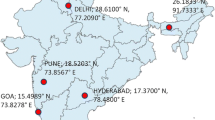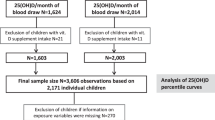Abstract
The relationship between personal UV exposure and vitamin D status was studied among 7 high school students from Davos, Switzerland from March to August 2013. The personal UV exposure was monitored using electronic dosimeters, while blood samples were taken at monthly intervals to determine the serum concentration of 25-hydroxyvitamin D3 (25(OH)D3). During school days students were exposed to 1.7% of the ambient UV irradiance, while 85% of the cumulative UV dose was obtained on weekends and holidays. Insufficient vitamin D levels in March (9 ng ml−1 25(OH)D3) rose to 25(OH)D3 concentrations of over 40 ng ml−1, meeting sufficient levels in August. The increase in vitamin D levels among 5 high school students correlated well (r = 0.89) with their measured personal UV exposure, yielding a mean increase in serum 25(OH)D3 concentration of 0.38 ± 0.22 ng ml−1 per 100 J m−2 of vitamin D-weighted UV exposure, a value consistent with other studies. During certain periods of the study, increases in vitamin D status and UV doses differed from the average of the whole study, implying that other factors must influence vitamin D metabolism.
Similar content being viewed by others
References
A. Webb and M. Holick, The role of sunlight in the cutaneous production of vitamin D3 Annu. Rev. Nutr. 1988 8 375–399.
J. MacLaughlin, R. Anderson and M. Holick, Spectral character of sunlight modulates photosynthesis of previtamin D3 and its photoisomers in human skin Science 1982 216, 4549, 1001–1003.
H. DeLuca, Metabolism of vitamin D: current status Am. J. Clin. Nutr. 1976 29, 11, 1258–1270.
M. Di Rosa, G. Malaguarnera, C. de Gregorio, M. Palumbo, G. Nunnari and L. Malaguarnera, Immuno-modulatory effects of vitamin D3 in human monocyte and macrophages Cell. Immunol. 2012 280, 1, 36–43.
M. Holick, Vitamin D: its role in cancer prevention and treatment Prog. Biophys. Mol. Biol. 2006 92, 1, 49–59.
J. Pettifor, Nutritional rickets: deficiency of vitamin D, calcium, or both? Am. J. Clin. Nutr. 2004 80, 6, 1725S–1729S.
M. Holick, Vitamin D deficiency N. Engl. J. Med. 2007 357, 3, 266–281.
R. McKenzie, J. Liley, L. Björn, UV radiation: balancing risks and benefits Photochem. Photobiol. 2009 85, 1, 88–98.
M. Holick and T. Chen, Vitamin D deficiency: a worldwide problem with health consequences Am. J. Clin. Nutr. 2008 87, 4, 1080S–1086S.
A. Webb, Who, what, where and when-influences on cutaneous vitamin D synthesis Prog. Biophys. Mol. Biol. 2006 92, 1, 17–25.
J. Gröbner, A. Albold, M. Blumthaler, T. Cabot, A. de la Casiniere, J. Lenoble, T. Martin, D. Masserot, M. Müller, R. Philipona, T. Pichler, E. Pougatch, G. Rengarajan, D. Schmucki, G. Seckmeyer, C. Sergent, M. Toure and P. Weihs, Variability of spectral solar ultraviolet irradiance in an Alpine environment J. Geophys. Res. 2000 105, D22, 26991–27003.
D. Sherman, Personal UV Dosimeter Badges: Mark II, NIWA UV Workshop, Queenstown, 7–9 April, 2010.
M. Allen, and R. McKenzie, Electronic UV Dosimeters for Research and Education, NIWA UV Workshop, Queenstown, 7–9 April, 2010.
E. Thieden, M. Agren and H. Wulf, The wrist is a reliable body site for personal dosimetry of ultraviolet radiation Photodermatol., Photoimmunol. Photomed. 2000 16, 2, 57–61.
P. Knuschke, Personal communication, 2013.
J. Gröbner, J. Schreder, S. Kazadzis, A. Bais, M. Blumthaler, P. Görts, R. Tax, T. Koskela, G. Seckmeyer, A. Webb and D. Rembges, Traveling reference spectroradiometer for routine quality assurance of spectral solar ultraviolet irradiance measurements Appl. Opt. 2005 44, 25, 5321–5331.
M. Holick, R. Bouillon, J. Eisman, M. Garabedian, J. Kleinschmidt, T. Suda, I. Terenetskaya, and A. Webb, Action Spectrum for the production of previtamin D3 in human skin, Commission Internationale de l’Éclairage, 2006, Technical Rep., ISBN 3 901 906 50 9.
G. Hülsen, J. Gröbner, Characterization and calibration of ultraviolet broadband radiometers measuring erythemally weighted irradiance Appl. Opt. 2007 46, 23, 5877–5886.
A. Wallace, The exposure treatment of burns Lancet 1951 1, 6653, 501–504.
P. Autier, M. Boniol, G. Severi, J. Dore, E. O. for Research and T. of Cancer Melanoma Co-operative Group, Quantity of sunscreen used by European students Br. J. Dermatol. 2001 144, 2, 288–291.
B. Petersen, P. Datta, P. Philipsen and H. Wulf, Sunscreen use and failures–on site observations on a sun-holiday Photochem. Photobiol. Sci. 2013 12, 1, 190–196.
S. Schalka, V. dos Reis and L. Cuce, The influence of the amount of sunscreen applied and its sun protection factor (SPF): evaluation of two sunscreens including the same ingredients at different concentrations Photodermatol., Photoimmunol. Photomed. 2009 25, 4, 175–180.
G. Hart, J. Furniss, D. Laurie and S. Durham, Measurement of vitamin D status: background, clinical use, and methodologies Clin. Lab. 2006 52, 78, 335–343.
H. Bischoff-Ferrari, E. Giovannucci, T. Willett, W. C. Dietrich, B. Dawson-Hughes, Estimation of optimal serum concentrations of 25-hydroxyvitamin D for multiple health outcomes Am. J. Clin. Nutr. 2006 84, 1, 18–28.
D. Wolpowitz and B. Gilchrest, The vitamin D questions: how much do you need and how should you get it? J. Am. Acad. Dermatol. 2006 54, 2, 301–317.
R. McKenzie, B. Liley, P. Johnston, R. Scragg, A. Stewart, A. Reeder and M. Allen, Small doses from artificial UV sources elucidate the photo-production of vitamin D Photochem. Photobiol. Sci. 2013 12, 9, 1726–1737.
R. McKenzie, M. Blumthaler, S. Diaz, V. Fioletov, J. Herman, G. Seckmeyer, A. Smedley, and A. Webb, Rationalizing Nomenclature for UV Doses and Effects on Humans, Commission Internationale de l’Éclairage, 2014, Report No. 211, ISBN 978-3-902842-35-0.
R. McKenzie, R. Scragg, B. Liley, P. Johnston, J. Wishart, A. Stewart and R. Prematunga, Serum 25-hydroxyvitamin-D responses to multiple UV exposures from solaria: inferences for exposure to sunlight Photochem. Photobiol. Sci. 2012 11, 7, 1174–1185.
Author information
Authors and Affiliations
Corresponding author
Rights and permissions
About this article
Cite this article
Gröbner, M., Gröbner, J. & Hülsen, G. Quantifying UV exposure, vitamin D status and their relationship in a group of high school students in an alpine environment. Photochem Photobiol Sci 14, 352–357 (2015). https://doi.org/10.1039/c4pp00324a
Received:
Accepted:
Published:
Issue Date:
DOI: https://doi.org/10.1039/c4pp00324a




